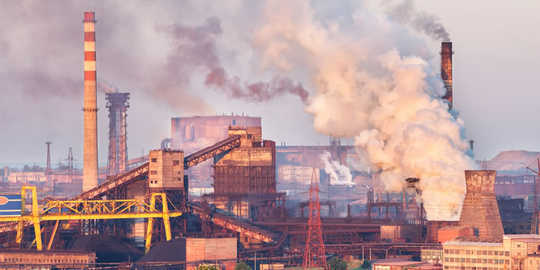
Harmful particulate matter in the atmosphere can produce birth defects and even fatalities during pregnancy, according to research in rats.
Using female rats, researchers examined the adverse health effects of exposure to fine particulate matter consisting of ammonium sulfate commonly found in many locations around the world. Researchers detected large fractions of this substance not only in Asia, but also in Houston (51 percent) and Los Angeles (31 percent).
During winter months in China and India, where severe haze events frequently occur, fine particulate matter levels were especially high at several hundred micrograms per cubic meter, the team concludes.
“…this certainly represents a major problem worldwide.”
Air pollution is a century-old problem for much of the world. According to the World Health Organization, 9 out of 10 people worldwide breathe air containing high level of pollutants, and 1 of every 9 global deaths can be attributed to exposure to air pollution, totaling over 7 million premature deaths a year.
Even in the United States, about one third of the population still live under poor air quality conditions, according to a report the US Environmental Protection Agency released in 2018.
“People typically believe that ammonium sulfate may not be terribly toxic, but our results show large impacts on female pregnant rats,” says co-lead author Renyi Zhang, a professor of atmospheric sciences and the chair in geosciences Texas A&M University. “It is unclear yet what is causing these profound effects, but we speculate that the size of nanoparticles or even the acidity may be the culprit.”
Zhang says sulfate is mainly produced from coal burning, which is a major energy source for much of the world in both developed and developing countries. Ammonium is derived from ammonia, which is produced from agricultural, automobile, and animal emissions, “so this certainly represents a major problem worldwide,” Zhang says.
“However, our results show that prenatal exposure to air pollution may not dispose offspring to obesity in adulthood,” says co-lead author Guoyao Wu, a professor of animal nutrition. “Nutrition and lifestyle are likely major factors contributing to the current obesity epidemic worldwide.”
Numerous previous studies have shown that air pollution is a serious public health threat throughout the world, with millions of people breathing air that does not meet standards the World Health Organization has set.
In addition, previous studies have shown such pollution to impair metabolic and immune systems in animal offspring, but the team’s study shows definitive proof of decreased fetal survival rates, and also shortened gestation rates that can result in smaller body weight, in addition to damage to brains, hearts, and other organs in the adult rat models.
The findings present obvious concerns and challenges on a multi-scale level, the team concludes.
“While epidemiological studies have been widely adopted to assess the health effects of air pollution, these tend to yield little insight into adverse outcomes and long-term effects,” Zhang says.
“Furthermore, there is an absence of clinical recommendations for prevention and treatment of air pollution-related health issues. Our study has demonstrated that well-controlled exposure experiments using animal models offer major advantages for future air pollution control and are promising in the development of therapeutic intervention and treatment procedures.”
The research appears in the Proceedings of the National Academy of Sciences. Additional researchers from Texas A&M University and the University of California, San Diego contributed to the work.
Support for the work came from the Tier One Program at Texas A&M, the Robert A. Welch Foundation, and the National Institute of Environmental Health Sciences.
Source: Texas A&M University
Books on The Environment from Amazon's Best Sellers list
"Silent Spring"
by Rachel Carson
This classic book is a landmark in the history of environmentalism, drawing attention to the harmful effects of pesticides and their impact on the natural world. Carson's work helped to inspire the modern environmental movement and remains relevant today, as we continue to grapple with the challenges of environmental health.
Click for more info or to order
"The Uninhabitable Earth: Life After Warming"
by David Wallace-Wells
In this book, David Wallace-Wells offers a stark warning about the devastating effects of climate change and the urgent need to address this global crisis. The book draws on scientific research and real-world examples to provide a sobering look at the future we face if we fail to take action.
Click for more info or to order
"The Hidden Life of Trees: What They Feel, How They Communicate?Discoveries from A Secret World"
by Peter Wohlleben
In this book, Peter Wohlleben explores the fascinating world of trees and their role in the ecosystem. The book draws on scientific research and Wohlleben's own experiences as a forester to offer insights into the complex ways that trees interact with one another and the natural world.
Click for more info or to order
"Our House Is on Fire: Scenes of a Family and a Planet in Crisis"
by Greta Thunberg, Svante Thunberg, and Malena Ernman
In this book, climate activist Greta Thunberg and her family offer a personal account of their journey to raise awareness about the urgent need to address climate change. The book provides a powerful and moving account of the challenges we face and the need for action.
Click for more info or to order
"The Sixth Extinction: An Unnatural History"
by Elizabeth Kolbert
In this book, Elizabeth Kolbert explores the ongoing mass extinction of species caused by human activity, drawing on scientific research and real-world examples to provide a sobering look at the impact of human activity on the natural world. The book offers a compelling call to action to protect the diversity of life on Earth.
al























